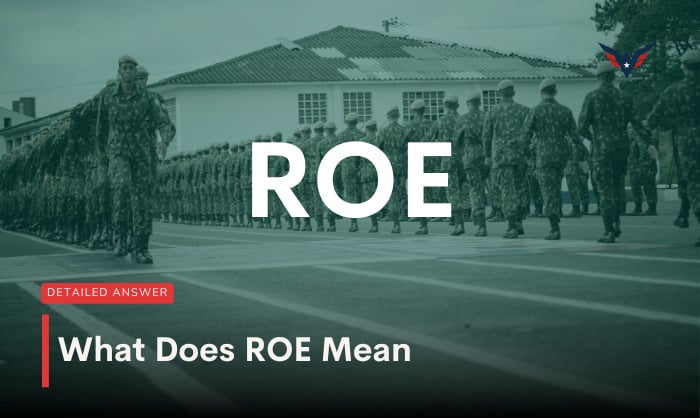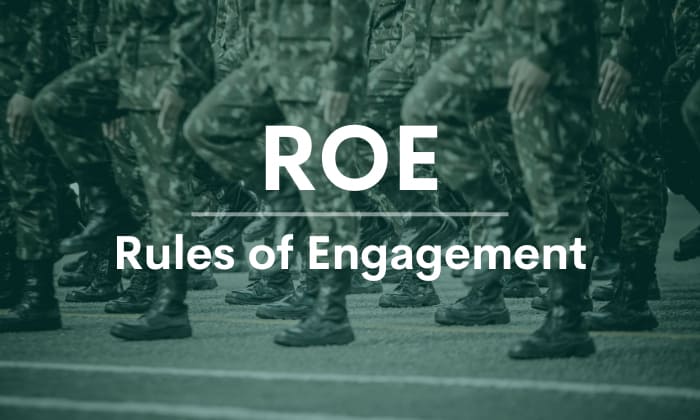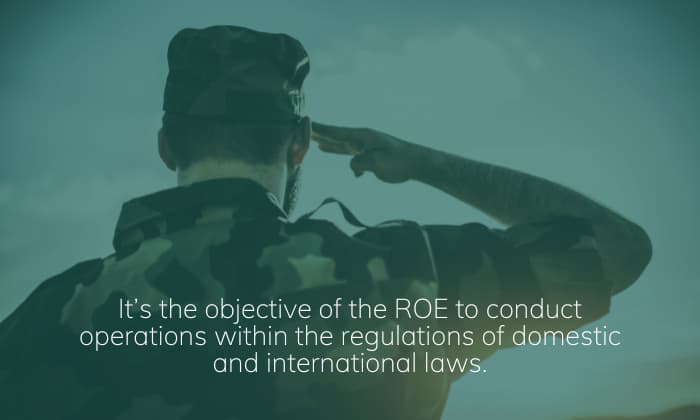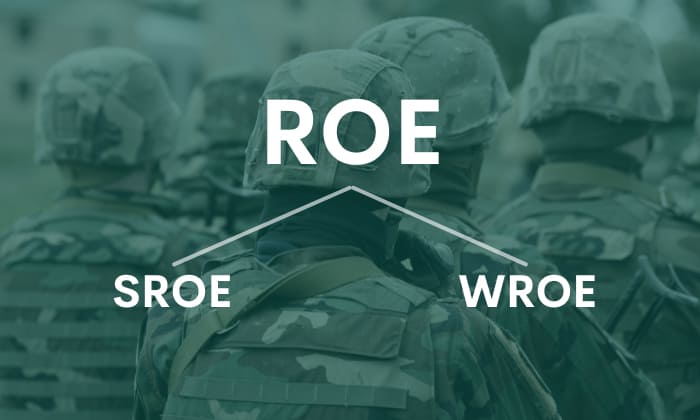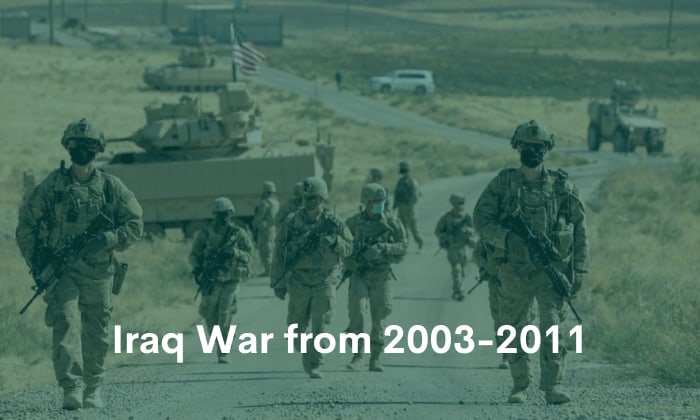If you’ve asked any US soldier, they’ll tell you that they follow the ROE to achieve their mission. So, what does ROE mean in military?
The meaning of ROE is the rules of engagement. They’re a set of directives aimed to help guide military commanders and personnel in the use of proper force against civilians and hostile attackers.
Continue reading to learn more about ROE below.
Table of Contents
Historical Background of ROE
The ROE military acronym stand for rules of engagement in war.
A competent military authority issues such orders in the form of ROE cards to outline the time, place, and process of using military forces for a specific mission. The document specifies the targets and weapons to use.
The evolution of ROE started during the Cold War, when military directives needed some serious upgrades due to the development of weapons and technologies. The first ROE draft was taken from the Laws of War (LOW) which focus on humanity in armed conflicts. The goal was to pacify the enemy while reducing collateral damage.
In 1994, the ROE was modified to address the results of hostile attacks from enemies in the U.S. military. One example was the suicide truck bomber who had annihilated hundreds of Marines in their post when the latter could not retaliate due to a lack of permission to fire.
Following the incident, the new Standing Rules of Engagement (SROE) were integrated with a key concept of self-defense.
The ROE serves a great significance in military decision-making. It guides the military leaders and personnel to employ the proper use of military force. With the ROE in mind, planning becomes easier during combat operations.
Objectives And Principles Of ROE – Importance of ROE
One of the objectives of ROE is to ensure that force deployment isn’t a violation of national security and policy. For example, the ROE may prohibit the engagement with specific targets to avoid aggravating the current issue.
Another objective of ROE is to regulate the use of force and set limits on how far military personnel can go to achieve the mission. Specific limits may be outlined regarding the type of weapons allowed to be authorized by the commander.
Lastly, it’s the objective of the ROE to conduct operations within the regulations of domestic and international laws.
To help achieve the military mission, ROE should be set according to the nation’s interests and military objectives. It shouldn’t be too limiting, but instead responsive to changes in the military environment. While the proper use of force is magnified, military forces should be allowed to use self-defense when hostile actions are imminent.
Components of ROE
ROE has rules for the use of force in many situations, such as for the defense of oneself and others, for the search, detention, and release of persons, and for protecting properties.
There are also guidelines on the use of weapon systems like landmines and cluster munitions; maritime and air operations; or humanitarian assistance and disaster relief. Depending on the mission, the rules and guidance will differ according to the objectives and tasks that need to be done.
ROE in practice
ROE differs from one country to another, which is why international military operations involve coordination between commanders to establish mission-specific rules.
Aside from this, soldiers receive training in ROE and take part in mission rehearsals before deployment.
Different Types Of ROE
There are two types of military rules of engagement popular in the US. Let’s discuss each one below.
SROE
Standing ROE applies to non-war situations, hence asking for limited military action. The terms of engagement state that the US military can use force in the act of self-defense against hostile enemies.
This scenario is easy to apply in international armed conflicts because the enemies often come in a different uniform, but it can be a little confusing for domestic combatants.
The unit commander has the inherent right to execute self-defense as a unit against any hostile actions and intentions. Individuals can exercise such rights when acting as part of a unit.
WROE
Wartime ROE applies to situations in which the US is in combat against a declared hostile force. Unlike SROE, WROE has no limit to military actions. The magnitude of the response has to be limited, though, to follow national policy.
Under these rules, a soldier can shoot an enemy on sight anytime. The war location may be restricted to a certain region to limit the damages of combat. It’s not legal to conduct military offenses in hospitals and other civilian institutions.
Factors Influencing ROE
ROE might not be effective at all times. Here are some factors affecting the compliance of ROE.
- Strategic military issues: The act of war may lead military forces to attack civilian populations to achieve the mission, for example, by setting a bomb with civilians around. Rich countries may also disregard international laws when fighting against a poorer country.
- Lack of knowledge: Simply the lack of knowledge about international norms might lead someone to disobey ROE. As a result, it’s imperative to inform the front liners about the humanitarian laws of war.
- Fear of prosecution: Dealing with hostilities in a domestic setting is more difficult than in an international one. You can’t determine the hostile enemy, hence, there’s a hesitation in apprehending the opponents.
Examples Of ROE In Military
One of the greatest rules of engagement examples is the Iraq War from 2003-2011. During this period, the US military was allowed to engage against an identified hostile attacker. Unless it’s self-defense, military forces weren’t allowed to strike civilians and other highly populated areas.
Another example is the ROE for Operation Restore Hope in Somalia. The mission of the military was to transport relief supplies to the population. Soldiers could only use force when attacked by people with hostile intent. Barbed wire fences were allowed, but not mines and other traps.
ROE Training And Implementation
To ensure compliance to ROE and the success of the whole mission, the rules of engagement must be reinforced to everyone in the US forces. The commanders are obliged to spread ROE throughout their units. Train the execution of every rule to ensure perfect compliance.
The most vital part of the training is the execution of self defense. It’s necessary to teach soldiers the provisions wherein they’re allowed to use force against a hostile attack. Specify the challenges that require a prompt response to specific missions.
A chain of command often implements ROE in the field. However, this can be a challenge when a quick response is needed in a situation. To address the problem immediately, the direct commander should be the one to decide what to do.
ROE In The Future
ROE is important in ensuring the efficacy and discipline of the armed force. It exists to minimize casualties and mistakes in conflicts, and will likely continue to serve that role for the foreseeable future.
Frequently Asked Questions
What happens if military personnel violate the Rules Of Engagement?
Military personnel can face serious consequences when ROE is violated. You can be dishonorably discharged from your service or forfeit all your pay and benefits. The worst-case scenario is to face jail time.
Are the Rules of Engagement the same for every military operation?
ROE is almost the same for every military operation because it follows the same international humanitarian laws. However, additional mandates might be added on a case-by-case basis.
Conclusion
At this point, I hope you know the answer to the question, “What does ROE mean in military?” It’s any rule involving uses of force that must be followed to avoid escalating the conflict. To ensure the proper execution of ROE, every military personnel should be trained appropriately.
Let us know what you think about ROEs in the military in the comment section below. Please share this article with your friends if you like it.

For an ex-serviceman, it is a pleasure for me to continue my work in The Soldiers Project. This site is built with the target to help people who work in security jobs and other people to gear themselves with high-quality equipment. It is essential for many duties that they have the protection required to perform with safety.

